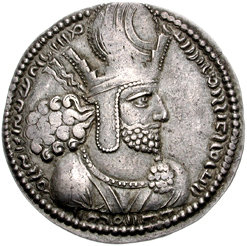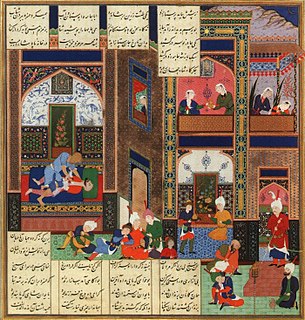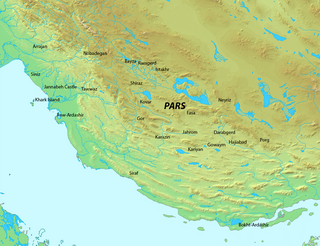
Yazdegerd III, was the last Sasanian King of Kings of Iran from 632 to 651. His father was Shahriyar and his grandfather was Khosrow II.

Shapur I, also known as Shapur the Great, was the second Sasanian King of Kings of Iran. The dating of his reign is disputed, but it is generally agreed that he ruled from 240 to 270, with his father Ardashir I as co-regent till the death of the latter in 242. Shapur consolidated and expanded the empire of Ardashir I, waging war against the Roman Empire, whom he seized the cities of Nisibis and Carrhae from, whilst advancing as far as Roman Syria. He was defeated at the Battle of Resaena in 243, but won the battle of Misiche in 244 and forcing the Romans to sign a favorable peace treaty the following year with the Roman emperor Philip the Arab, which was regarded by the Romans as "a most shameful treaty".

Shapur II, also known as Shapur II the Great, was the tenth Sasanian king (shah) of Iran. The longest-reigning monarch in Iranian history, he reigned for his entire 70-year life from 309 to 379. He was the son of Hormizd II.

The Muslim conquest of Persia, also known as the Arab conquest of Iran, led to the fall of the Sasanian Empire of Iran (Persia) in 651 and the eventual decline of the Zoroastrian religion.

The Sasanian era is one of the most influential periods in Iran's history. It also marks the third rise of a great Iranian empire, a dynasty that rivaled its predecessor, the Achaemenids, who too, like the Sassanids, were native to the province of Pars, and in some instances the Parthians, in glory and power. Although it fought many campaigns against the Romans/Byzantines in the west and the nomadic people in the east and north, the Sasanian Empire met its demise not by the Byzantine-Roman Empire, but by emerging Arab Muslims from across its southern borders. However, the conflict with the Byzantines greatly contributed to its weakness, by draining Sassanid resources, leaving it a prime target for the Muslims.

Rostam Farrokhzād was an Iranian nobleman from the Ispahbudhan family, who served as the spahbed of Adurbadagan and Khorasan during the reign of Boran and Yazdegerd III. Rostam is remembered as a historical figure, a character in the Persian epic poem Shahnameh, and as a touchstone of most Iranian nationalists.

The Battle of Nahāvand was fought in 642 between Arab Muslims and Sassanid armies. The battle is known to Muslims as the "Victory of Victories." The Sassanid King Yazdegerd III escaped to the Merv area, but was unable to raise another substantial army. It was a decisive victory for the Rashidun Caliphate and the Persians consequently lost the surrounding cities including Spahan.

Mazun was a Sasanian province in Late Antiquity, which corresponded to modern day Bahrain, Qatar, United Arab Emirates, and the northern half of Oman. The province served as a Sasanian outpost, and played an important role in the Sasanian efforts to gain control over the Indian Ocean trade, and to establish their dominance in the wealthy regions of Hadramaut and Yemen.

The Sasanian Empire, officially known as the Empire of Iranians, also called the Neo-Persian Empire by historians, was the last kingdom of the Persian Empire before the rise of Islam. Named after the House of Sasan, it ruled from 224 to 651 AD. The Sasanian Empire succeeded the Parthian Empire and was recognised as one of the leading world powers alongside its neighbouring arch-rival, the Roman-Byzantine Empire for a period of more than 400 years.
Hormuzan was an Iranian aristocrat who served as the governor of Khuzestan, and was one of the Sasanian military officers at the Battle of al-Qādisiyyah. He was later taken prisoner by the Muslims after the fall of Shushtar in 642. Two years later, he was accused of the assassination of the Rashidun caliph Umar, and was killed by 'Ubaid-Allah, the deceased caliph's son.
Farrukhzad, was an Iranian aristocrat from the House of Ispahbudhan and the founder of the Bavand dynasty, ruling from 651 to 665. Originally a powerful servant of the Sasanian king Khosrow II, he, along with several other powerful aristocrats made a conspiracy against the latter and ended his tyrannical rule. They thereafter put Khosrow's son Kavadh II on the throne, whose rule lasted only a few months, before he was killed by a plague, being succeeded by his son Ardashir III, who was only after one year murdered by the rebellious former Sasanian army chief (spahbed) Shahrbaraz, who usurped the throne.
Bahman Jādhūyah/Jādūyah, or Bahman Jādhawayh was an Iranian general of the Sasanians. He is mostly known to have led the Sasanians to victory against the Arabs at the Battle of the Bridge. The Arab Muslims referred to Bahman as Dhul Hājib. He had a reputation for being anti-Arab. He is often confused with Mardanshah, another Sasanian general.
The dehqân, were a class of land-owning magnates during the Sasanian and early Islamic period, found throughout Iranian-speaking lands.

The Shapur II's Arab campaign took place in 325, against numerous Arab tribes, due to the Arab incursions into the Sasanian Empire. Shapur II decisively defeated all the Arab tribes during his campaign, and became known as Dhū al-Aktāf to the Arabs, meaning “he who pierces shoulders”.

The House of Sasan was the house that founded the Sasanian Empire, ruling this empire from 224 to 651. It began with Ardashir I, who named the dynasty as Sasanian in honour of his grandfather, Sasan, and after the name of his tribe.

The Muslim conquest of Pars took place from 638/9 to 650/1, and ended with subjugation of the important Sasanian province of Pars to the Rashidun Caliphate.

The Siege of Shushtar was fought from 641 to 642 between the Sasanian Empire and the invading Arab Muslims of the Rashidun Caliphate. Shushtar was an ancient strong stronghold in Khuzestan, and was attacked by the Arabs under their commander Abu Musa Ashaari. Although the city managed to resist the Arabs, the Sasanians later faced desertion, which resulted in the Arabs capturing the city and capturing its commander, Hormuzan.
Busbuhra was a local ruler of Aramean origin, who shifted alliance between the Rashidun Caliphate and the Sasanian Empire, to remain on his throne.

Pars was a Sasanian province in Late Antiquity, which almost corresponded to the present-day province of Fars. The province bordered Khuzestan in the west, Kirman in the east, Spahan in the north, and Mazun in the south.

The Canadians′ Choice Party (CCP) is a minor political party in Ontario, Canada. The party is led by Bahman Yazdanfar.














